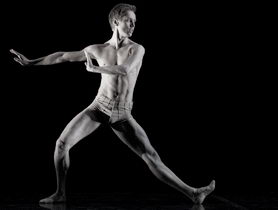14.09.2012
Leonid Sarafanov reaching new levels of expression and mastery under Nacho Duato at the Mikhailovsky
After nine years with the Kirov (Maryinsky) Ballet, principal dancer Leonid Sarafanov upped stakes in January 2011 and moved a few grand jetes away to start work at the Mikhailovsky Ballet situated by the Russian Museum in St. Petersburg. His wife and regular partner, Oleysia Novikova, is still dancing at the Maryinsky Theatre and the Sarafanov family, which includes 17-month-old son Aleksei, now has a very different “timetable” — when Sarafanov is on tour, Novikova is in St. Petersburg; when she has a day off, he is busy rehearsing; and their holidays are during different months. In an interview with Dance International, Sarafanov spoke of the reasons for his move.
Sarafanov has been regularly hailed as a beautiful classical dancer, someone whose future looked firmly secured in the Maryinsky company. The Mikhailovsky Ballet, where Sarafanov has now transferred his affections and talents, is St. Petersburg’s number two company. The Mikhailovsky Theatre, a stunning pale yellow building with white trim, was opened in 1833 by Grand Duke Mikhail, brother of Nicholas I and was home to a French dramatic company. The Russian Revolution of 1917 saw the departure of foreigners and the theatre underwent several metamorphoses of names: the State Academic Comic Theatre in 1920, the Maly Academic Theatre in 1921 and the Leningrad Academic Maly Opera Theatre five years later. In 2001, it returned to its original name of Mikhailovsky Theatre. It has seen many famous cultural icons — both from the opera as well as the ballet world and ballet directors include Leonid Lavrovsky (1930s) and, from 1973 to 1977, Oleg Vinogradov before he took.
“The thought (of transferring) first occurred to me when former Kirov director Makhar Vaziev left in 2008. But I didn’t start thinking about this seriously until a year ago. Then I was approached by Mr. Kekhman, general director of the Mikhailovsky Theatre, who told me, without mentioning any names, that a world-class choreographer would soon be directing the Mikhailovsky Ballet and encouraged me to join. I guessed it might be Nacho Duato he was talking about, having heard that he had ended his contract in Spain, but I wasn’t sure. Another reason for leaving was that we had practically stopped performing any contemporary work. Back in 2005 I mentioned in an interview that I would love to work with Duato, but I never imagined it would happen in this way. The fact that Mr. Duato was taking up a permanent position in St. Petersburg was almost too good to be true. It is almost like ‘the mountain coming to Mohammed!’ So, while I had more or less made my decision already, the news of Mr. Duato’s appointment clinched it for me.”
Since 2003, Leonid Sarafanov has been one of the most popular male dancers of one of the world’s leading
classical ballet companies founded in the 18th century — the Maryinsky Ballet. His youthful Peter Pan features and demeanour, cheeky grin and wide-eyed look have made him a favourite of international audiences as well as those back home. Tall, slim with well-proportioned limbs, Sarafanov is an elegant princely danceur noble, as well as being a true virtuoso performer, offering space-devouring action and high, light elevation. His soft port de bras and easy performing style make his dancing look effortless and natural, and he is a sought-after partner. His footwork is fastidious, as was seen in such ballets as Etudes, while he showed his allure and charm in the traditional classical roles of Solor, Albrecht and Basil. However, he has also proved himself in the more contemporary works of choreographers like William Forsythe —though most of his many fans prefer to see him as the handsome fairy-tale prince. All in all, over the Kirov Ballet, followed by Nikolai Boyarchikov. The last director was the famed exotic ex-principal of the Kirov Ballet, Farouk Ruzimatov whose tenure was surprisingly broken a year ago.
Last summer, led by acting director and ballet master, Mikhail Messerer, the company made a highly successful tour to London and received excellent reviews from the British critics for its high standard of classical technique and style, accomplished by the careful coaching and teaching of such classical ballet luminaries as Nikita Dolgushin, Tatiana Legat, Zhanna Ayupova and Messerer. Then, suddenly and totally unexpectedly on the company’s return to St. Petersburg, it broke with tradition and changed direction by appointing Spanish contemporary choreographer and director Duato to take over the helm of this established classical company. It was a coup that astounded not only the Russians, but also the Western world, making Duato the first foreigner to lead a Russian company in more than 100 years. He was director of Spain’s National Dance Company from 1990 and as a popular contemporary choreographer, his vast repertoire of works can be found in many of the world’s top dance companies.
Now the Spaniard will premiere his new ballets on the Mikhailovsky stage — a very clever move for a company that has always had to compete in its traditional classical heritage with its nearest and world-famous rivals, the Bolshoi in Moscow and its neighbour, the Maryinsky. The decision for change of director was made by Vladimir Kekhman, a wealthy businessman. General director of the theatre since 2007, he had the vision and the financial opportunity to expand the image of the ballet company making it different from other classical companies in Russia today.
For dancers in Russia, it is a rare privilege to work with a choreographer and not just repetiteurs and coaches and they are happy to be a part of the cutting-edge movement, based on combining classical repertoire with contemporary ballets, some of which will receive their world premiere at the Mikhailovsky.
“I am already dancing more at the Mikhailovsky than I was at the Maryinsky,” he said after his second month there, “and I have a busy schedule. I am relieved that I will have to do less guesting. As for style ... classical ballet is the same the world over, though I know that Duato plans to make some amendments, though not radical. He has a great respect for the classical legacy. As for contemporary dance — that will depend entirely on him. I expect to be dancing most of the ‘hits’ of the classical repertoire here this season: Swan Lake, Sleeping Beauty, Le Corsaire, Don Quixote, La Bayadere, Giselle and I will also be dancing in two one-act ballets by Duato.
And how differently does he have to dance in Duato’s style? “The routine is similar, but more intense,” he answers. “We have class every morning, then rehearsals afternoon and evening. We get one proper day off a week, which makes a nice change. I am excited and very positive about my new work. Duato is demanding, inspiring and focused, and I learn something new at every lesson. He is extremely musical and this is what is most different from the way I have worked before; I am learning to use my body like a musical instrument. One thing that impressed me immediately is that most choreographers beat time, but Duato doesn’t do this: he makes us really ‘tune in’ and listen to the music. He also requires beauty of line, discipline and technique. My strong grounding in classical ballet means I am also able to contribute to the process and put my experience toward what Duato wants to achieve. This is what I wanted from making this move, to grow and develop as an artist, reach new levels of expression and mastery. The chance to work with a choreographer day in day out, the chance to develop something together, is fabulous — until now I only worked with choreographers on a project basis. How about the style — is it very different from the contemporary works Sarafanov has danced before? “Nacho asks us to keep out legs parallel and to stand ‘normally’ — which is unusual. Occasionally I forget and strike my ‘Prince’ pose — standing normally takes some getting used to. I will continue to dance both styles. I made it as a classical dancer and I will continue to dance classical repertoire as long as my body permits. But, I am determined to add to this, to learn new movements, new choreography, master a new language. I want to evolve as a dancer.”
Editor’s Note: Igor Stupnikov, professor, historian and dance writer in St. Petersburg, attended Nacho Duato’s premiere triple bill programme in which Leonid Sarafanov appeared in Without Words. Stupnikov writes, “Sarafanov’s variation was beautifully done, changes of body angles were juicy and he brought fine articulation to the difficult choreography, a style that was quite new to him. He was always in tune with the music and gave his piece spaciousness and glamour. His role demanded much legwork and turns of coloratura rapidity, and it was thrilling to see the fullness with which Sarafanov delivered these choreographic combinations. His long-limbed physique looked wonderful with his vividness, speed and lightness, and he danced with complete absorption and energetic sweep.”
Margaret Willis
Dance International
Sarafanov has been regularly hailed as a beautiful classical dancer, someone whose future looked firmly secured in the Maryinsky company. The Mikhailovsky Ballet, where Sarafanov has now transferred his affections and talents, is St. Petersburg’s number two company. The Mikhailovsky Theatre, a stunning pale yellow building with white trim, was opened in 1833 by Grand Duke Mikhail, brother of Nicholas I and was home to a French dramatic company. The Russian Revolution of 1917 saw the departure of foreigners and the theatre underwent several metamorphoses of names: the State Academic Comic Theatre in 1920, the Maly Academic Theatre in 1921 and the Leningrad Academic Maly Opera Theatre five years later. In 2001, it returned to its original name of Mikhailovsky Theatre. It has seen many famous cultural icons — both from the opera as well as the ballet world and ballet directors include Leonid Lavrovsky (1930s) and, from 1973 to 1977, Oleg Vinogradov before he took.
“The thought (of transferring) first occurred to me when former Kirov director Makhar Vaziev left in 2008. But I didn’t start thinking about this seriously until a year ago. Then I was approached by Mr. Kekhman, general director of the Mikhailovsky Theatre, who told me, without mentioning any names, that a world-class choreographer would soon be directing the Mikhailovsky Ballet and encouraged me to join. I guessed it might be Nacho Duato he was talking about, having heard that he had ended his contract in Spain, but I wasn’t sure. Another reason for leaving was that we had practically stopped performing any contemporary work. Back in 2005 I mentioned in an interview that I would love to work with Duato, but I never imagined it would happen in this way. The fact that Mr. Duato was taking up a permanent position in St. Petersburg was almost too good to be true. It is almost like ‘the mountain coming to Mohammed!’ So, while I had more or less made my decision already, the news of Mr. Duato’s appointment clinched it for me.”
Since 2003, Leonid Sarafanov has been one of the most popular male dancers of one of the world’s leading
classical ballet companies founded in the 18th century — the Maryinsky Ballet. His youthful Peter Pan features and demeanour, cheeky grin and wide-eyed look have made him a favourite of international audiences as well as those back home. Tall, slim with well-proportioned limbs, Sarafanov is an elegant princely danceur noble, as well as being a true virtuoso performer, offering space-devouring action and high, light elevation. His soft port de bras and easy performing style make his dancing look effortless and natural, and he is a sought-after partner. His footwork is fastidious, as was seen in such ballets as Etudes, while he showed his allure and charm in the traditional classical roles of Solor, Albrecht and Basil. However, he has also proved himself in the more contemporary works of choreographers like William Forsythe —though most of his many fans prefer to see him as the handsome fairy-tale prince. All in all, over the Kirov Ballet, followed by Nikolai Boyarchikov. The last director was the famed exotic ex-principal of the Kirov Ballet, Farouk Ruzimatov whose tenure was surprisingly broken a year ago.
Last summer, led by acting director and ballet master, Mikhail Messerer, the company made a highly successful tour to London and received excellent reviews from the British critics for its high standard of classical technique and style, accomplished by the careful coaching and teaching of such classical ballet luminaries as Nikita Dolgushin, Tatiana Legat, Zhanna Ayupova and Messerer. Then, suddenly and totally unexpectedly on the company’s return to St. Petersburg, it broke with tradition and changed direction by appointing Spanish contemporary choreographer and director Duato to take over the helm of this established classical company. It was a coup that astounded not only the Russians, but also the Western world, making Duato the first foreigner to lead a Russian company in more than 100 years. He was director of Spain’s National Dance Company from 1990 and as a popular contemporary choreographer, his vast repertoire of works can be found in many of the world’s top dance companies.
Now the Spaniard will premiere his new ballets on the Mikhailovsky stage — a very clever move for a company that has always had to compete in its traditional classical heritage with its nearest and world-famous rivals, the Bolshoi in Moscow and its neighbour, the Maryinsky. The decision for change of director was made by Vladimir Kekhman, a wealthy businessman. General director of the theatre since 2007, he had the vision and the financial opportunity to expand the image of the ballet company making it different from other classical companies in Russia today.
For dancers in Russia, it is a rare privilege to work with a choreographer and not just repetiteurs and coaches and they are happy to be a part of the cutting-edge movement, based on combining classical repertoire with contemporary ballets, some of which will receive their world premiere at the Mikhailovsky.
“I am already dancing more at the Mikhailovsky than I was at the Maryinsky,” he said after his second month there, “and I have a busy schedule. I am relieved that I will have to do less guesting. As for style ... classical ballet is the same the world over, though I know that Duato plans to make some amendments, though not radical. He has a great respect for the classical legacy. As for contemporary dance — that will depend entirely on him. I expect to be dancing most of the ‘hits’ of the classical repertoire here this season: Swan Lake, Sleeping Beauty, Le Corsaire, Don Quixote, La Bayadere, Giselle and I will also be dancing in two one-act ballets by Duato.
And how differently does he have to dance in Duato’s style? “The routine is similar, but more intense,” he answers. “We have class every morning, then rehearsals afternoon and evening. We get one proper day off a week, which makes a nice change. I am excited and very positive about my new work. Duato is demanding, inspiring and focused, and I learn something new at every lesson. He is extremely musical and this is what is most different from the way I have worked before; I am learning to use my body like a musical instrument. One thing that impressed me immediately is that most choreographers beat time, but Duato doesn’t do this: he makes us really ‘tune in’ and listen to the music. He also requires beauty of line, discipline and technique. My strong grounding in classical ballet means I am also able to contribute to the process and put my experience toward what Duato wants to achieve. This is what I wanted from making this move, to grow and develop as an artist, reach new levels of expression and mastery. The chance to work with a choreographer day in day out, the chance to develop something together, is fabulous — until now I only worked with choreographers on a project basis. How about the style — is it very different from the contemporary works Sarafanov has danced before? “Nacho asks us to keep out legs parallel and to stand ‘normally’ — which is unusual. Occasionally I forget and strike my ‘Prince’ pose — standing normally takes some getting used to. I will continue to dance both styles. I made it as a classical dancer and I will continue to dance classical repertoire as long as my body permits. But, I am determined to add to this, to learn new movements, new choreography, master a new language. I want to evolve as a dancer.”
Editor’s Note: Igor Stupnikov, professor, historian and dance writer in St. Petersburg, attended Nacho Duato’s premiere triple bill programme in which Leonid Sarafanov appeared in Without Words. Stupnikov writes, “Sarafanov’s variation was beautifully done, changes of body angles were juicy and he brought fine articulation to the difficult choreography, a style that was quite new to him. He was always in tune with the music and gave his piece spaciousness and glamour. His role demanded much legwork and turns of coloratura rapidity, and it was thrilling to see the fullness with which Sarafanov delivered these choreographic combinations. His long-limbed physique looked wonderful with his vividness, speed and lightness, and he danced with complete absorption and energetic sweep.”
Margaret Willis
Dance International



